Rippling Along
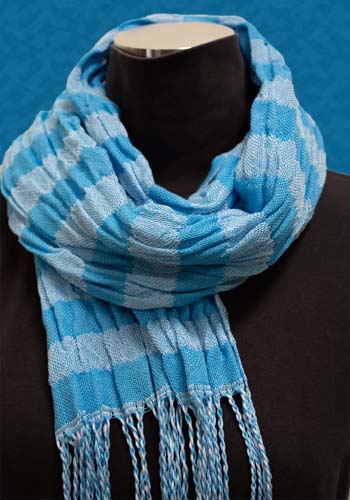

Post written by Michele Belson
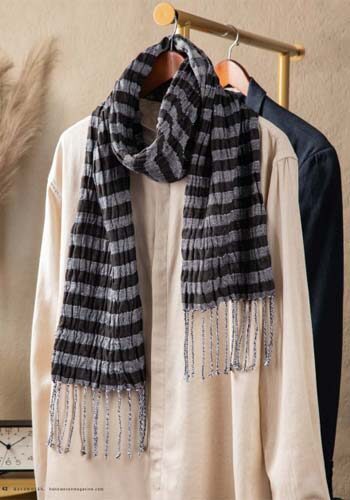 We LOVE the Ripple Scarf by Denise Kovnat in the Nov/Dec 2022 issue of Handwoven. In part, because it uses our beautiful 20/2 mercerized cotton yarn and the exciting active Linen Crepe yarn. 20/2 mercerized cotton yarn is a favored child of mine and combining it with a yarn from the GevolveYarns is a perfect combination. Of course, I had to weave it.
We LOVE the Ripple Scarf by Denise Kovnat in the Nov/Dec 2022 issue of Handwoven. In part, because it uses our beautiful 20/2 mercerized cotton yarn and the exciting active Linen Crepe yarn. 20/2 mercerized cotton yarn is a favored child of mine and combining it with a yarn from the GevolveYarns is a perfect combination. Of course, I had to weave it.
Rhapsody in Blues
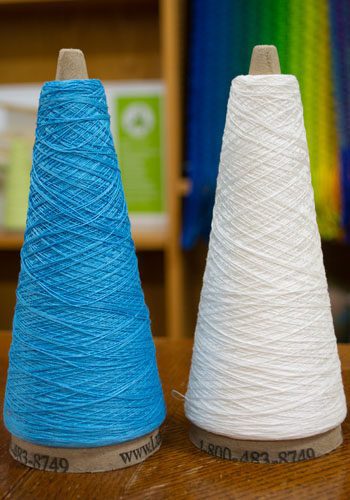 I worked for years at the Florida School of Theatre and wore black clothes backstage. Now that I am back to being a Lunatic full time, I am enjoying adding a bit of color to my wardrobe. Lately, the color blue has been making me really happy. So rather than weave the Ripple Scarf in Black as Denise designed it, I choose Sky Blue for the 20/2 yarn color. The watery color and the watery ripples seemed like a natural choice, and pairing the Sky Blue with Bleached White would make a lovely scarf.
I worked for years at the Florida School of Theatre and wore black clothes backstage. Now that I am back to being a Lunatic full time, I am enjoying adding a bit of color to my wardrobe. Lately, the color blue has been making me really happy. So rather than weave the Ripple Scarf in Black as Denise designed it, I choose Sky Blue for the 20/2 yarn color. The watery color and the watery ripples seemed like a natural choice, and pairing the Sky Blue with Bleached White would make a lovely scarf.
Making the Flowing warp
The project has 540 warp ends. Because that is quite a few ends to thread, I wanted to put on enough warp for 2 or 3 scarves. And enough for some samples for our Guild sample box. Winding the warp was easy, with 2 ends at a time, one end 20/2 Bleached White and one end 20/2 Sky Blue. Winding two ends at a time is a labor-saving technique that I am teaching in the Warped to Weave class. The 540 ends were wound in no time at all.
Heddle dilemma
The draft is only 4 shafts!!! However, it is made from 20/2 yarn, in doubleweave at 36 epi and uses more heddles (135) than the 110 per shaft we have on our 4-shaft wolf pup loom. My first thought to reduce the number of heddles needed was to make the scarf a bit narrower. The original scarf is 15” in the reed, and the finished product lost 20% in width to be a finished 12” scarf. Therefore, if I reduce the pattern to 12” in the reed, the finished scarf would be around 9.6” and still be a respectable scarf. With that reduction, it would use only 108 heddles per shaft. A bit close for comfort, but it would work. Then, I looked over at my empty 8-shaft Baby Wolf loom. If I spread the pattern over 8-shafts, I’d use only 67 or 68 heddles per shaft, even with the original 15” width in the reed. And the 8-shaft baby wolf loom has 10 treadles, so I can do the treadling sequence without pushing 2 treadles at a time. Not that that’s difficult, but it seemed more straight forward. Using all 8-shafts would be more to lift, but worth it to keep the additional width and to make weaving easier.
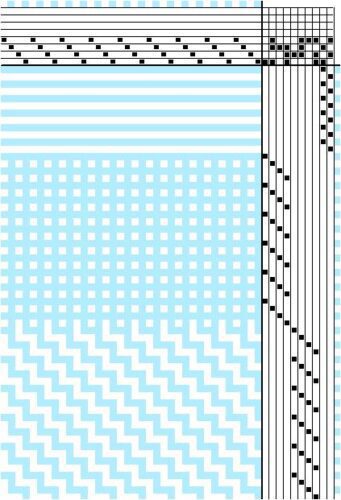
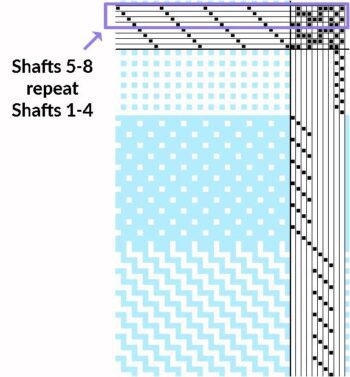 On the left is the original 4-shaft draft from Handwoven Magazine, and on the right is an 8-shaft draft that weaves the same fabric. You can see for the 8-shaft draft I just set another set of 4-shafts behind the first set.
On the left is the original 4-shaft draft from Handwoven Magazine, and on the right is an 8-shaft draft that weaves the same fabric. You can see for the 8-shaft draft I just set another set of 4-shafts behind the first set.
So, onto the 8-shaft Baby Wolf the warp went. By lifting odd and even shafts occasionally, and carefully counting out 8 threads and 8 heddles I got 540 ends on with one minor threading error that I spotted and corrected right away before I started weaving.
Double Weaving
I am so glad that I wove the scarf. The Handwoven article didn’t emphasize the loose layers of doubleweave that allow the ripple effect to happen. There are two treadled stripes exchanging the Sky Blue and White as the top layer of doubleweave. One stripe woven with a single shuttle of 20/2 sky blue it and goes really fast. The top layer for this stripe is solid Sky Blue, and the bottom layer is a plain weave mix of Sky Blue and White. The other stripe is woven with two shuttles: 20/2 Sky Blue and Linen Crepe. The top layer for this stripe is a plain weave mix of Sky Blue and White, and the bottom layer is Linen Crepe and Sky Blue.
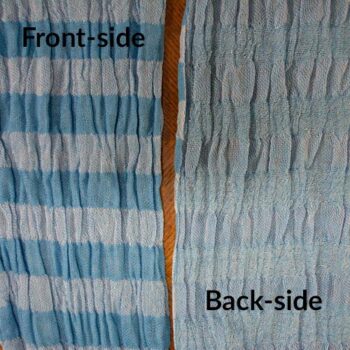 This picture shows the front side of the scarf and turned over for the back-side. The two layers look very different, and when you are weaving, you see the front-side. Each layer has 18 ends per inch: this is VERY loose for 20/2 cotton. This loose sett gives a gauzy look to the cloth but more importantly gives the linen room to scrunch up. I am learning that active yarns need space to do their thing!!!
This picture shows the front side of the scarf and turned over for the back-side. The two layers look very different, and when you are weaving, you see the front-side. Each layer has 18 ends per inch: this is VERY loose for 20/2 cotton. This loose sett gives a gauzy look to the cloth but more importantly gives the linen room to scrunch up. I am learning that active yarns need space to do their thing!!!
Thank you, Jennifer Moore!
The weaving of this scarf is easy and straight forward. I was glad I had recently participated in Jennifer Moore’s Double Rainbow Doubleweave class. The techniques Jennifer uses to keep track of the treadling in doubleweave helped me keep track of the two shuttles and weaving the two layers of fabric. Here is a video of weaving the scarf on our You-tube channel.
Picks per inch?
I didn’t get the suggested ppi of 64. Mine is closer to 36, but I like the look and feel of the cloth. The habit of weaving square is pretty ingrained in me! Doing the math, 64 ends per inch is 32 ends per inch per layer. 48 ends (1,2,3,4 X 12 = 48) should have been about .75 inches. When I did count, weave and measure those 48 picks, I was getting 1.25” but I like the look and feel of the cloth. On a later sample (before the second scarf) I tried to beat it in to 64 epi and prefer the first one I wove. After a couple of stripes, I wove to measurement rather than counting for 2 reasons. Counting 20/2 on the loom is a daunting task and I am completely unable to count 48 rows without losing count. So I used my trusty measuring tape and measured 1.25” per stripe.
End treatment
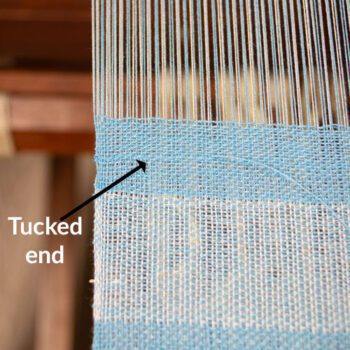
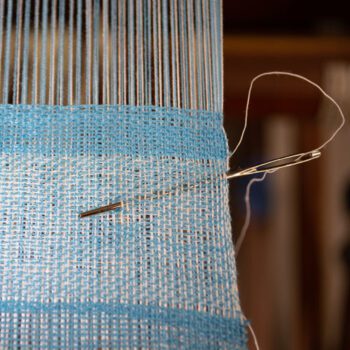 I experimented with ways of tucking in the ends. Every stripe woven with the linen crepe has 2 loose ends. And there are occasional loose ends of 20/2 when a bobbin runs out. I folded some ends into the web, my usual method, but in the fine, gauzy fabric the ends showed more than I like. Again, deferring to Jennifer Moore and how she deals with ends in double woven cloth, I left about 4” long ends hanging out the side and AFTER the cloth came off the loom, using a needle, I fed the end into the space between the layers of doubleweave. And the ends disappeared. It took a few minutes, but I think it was well worth the time. On the next scarf, I will bury the ends before I wash it. It may be easier…. I just couldn’t wait to see it scrunch up!!! It is possible the turned in weft tails won’t be noticeable after washing, but I didn’t want to find out!!
I experimented with ways of tucking in the ends. Every stripe woven with the linen crepe has 2 loose ends. And there are occasional loose ends of 20/2 when a bobbin runs out. I folded some ends into the web, my usual method, but in the fine, gauzy fabric the ends showed more than I like. Again, deferring to Jennifer Moore and how she deals with ends in double woven cloth, I left about 4” long ends hanging out the side and AFTER the cloth came off the loom, using a needle, I fed the end into the space between the layers of doubleweave. And the ends disappeared. It took a few minutes, but I think it was well worth the time. On the next scarf, I will bury the ends before I wash it. It may be easier…. I just couldn’t wait to see it scrunch up!!! It is possible the turned in weft tails won’t be noticeable after washing, but I didn’t want to find out!!
Bobbin Bobbin, it is all about the bobbin
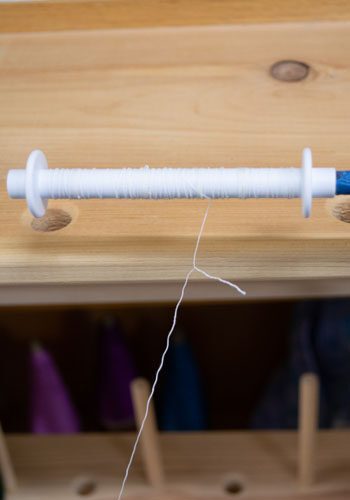 Denise was absolutely right that winding the active bobbins is the most challenging part of this project. A hand crank bobbin winder is a must! The linen thread package must be close to the winder, and the yarn needs to take a direct path to the winder. There will be places where the yarn plies back on itself. Firm tension will pull those out. And the linen is quite strong. Denise said it wouldn’t break, but I had a few breaks where the twists just wouldn’t come out. I took several bobbins to the winder and when a break happened, I used the next bobbin. Some bobbins were pretty fat, others not so much. Because the active yarn is only ¼ of the weft, I had enough weft wound onto bobbins after 2 sessions at the winder. Here is another link to see the bobbin winding.
Denise was absolutely right that winding the active bobbins is the most challenging part of this project. A hand crank bobbin winder is a must! The linen thread package must be close to the winder, and the yarn needs to take a direct path to the winder. There will be places where the yarn plies back on itself. Firm tension will pull those out. And the linen is quite strong. Denise said it wouldn’t break, but I had a few breaks where the twists just wouldn’t come out. I took several bobbins to the winder and when a break happened, I used the next bobbin. Some bobbins were pretty fat, others not so much. Because the active yarn is only ¼ of the weft, I had enough weft wound onto bobbins after 2 sessions at the winder. Here is another link to see the bobbin winding.
Let’s see it scrunch up!
The washing instructions are simple. I had a hard time letting the scarf soak for the prescribed 5 minutes. Patience isn’t my greatest virtue. Warm water seemed to be a must. I started with cool water and didn’t get much action, so I added warm water and the linen yarn drew in nicely.
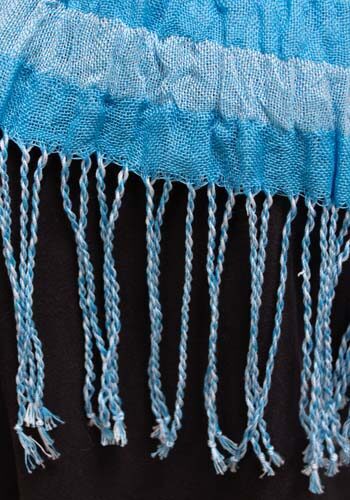 My fringes are plied a bit finer. Force of habit and failure to read the instructions. There are 16 ends in each fringe. Maybe on the next one I’ll make bigger bundles…. It is all really a matter of taste.
My fringes are plied a bit finer. Force of habit and failure to read the instructions. There are 16 ends in each fringe. Maybe on the next one I’ll make bigger bundles…. It is all really a matter of taste.
And now, even more than before, I LOVE, LOVE, LOVE this scarf! Michele Belson
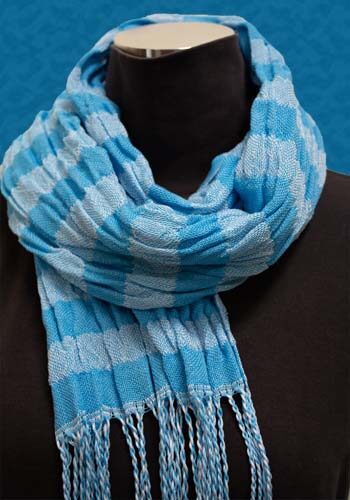


Michele,
The scarf looks beautiful! And you’re absolutely right: Active yarns typically need lots of space to move about and create pleats or curves. How in the heck you and I could could use the same draft and yarns — and then use vastly different beats — shows you just how flexible these textural designs can be, in my view. Or maybe that’s just the beauty of weaving itself, that it allows for lots of individual expression.
Thank you so much, Michelle, for the insights into weaving this scarf and especially for the videos. I have been toying with the idea of weaving this scarf and in a denim shade. However, I was a little intimidated by the fineness of the yarn and the active yarn as I am not accustomed to weaving with them. After reading this article and watching the videos, I feel braver about taking on the project. Now that I have seen the blue one, I will definitely give it a try.